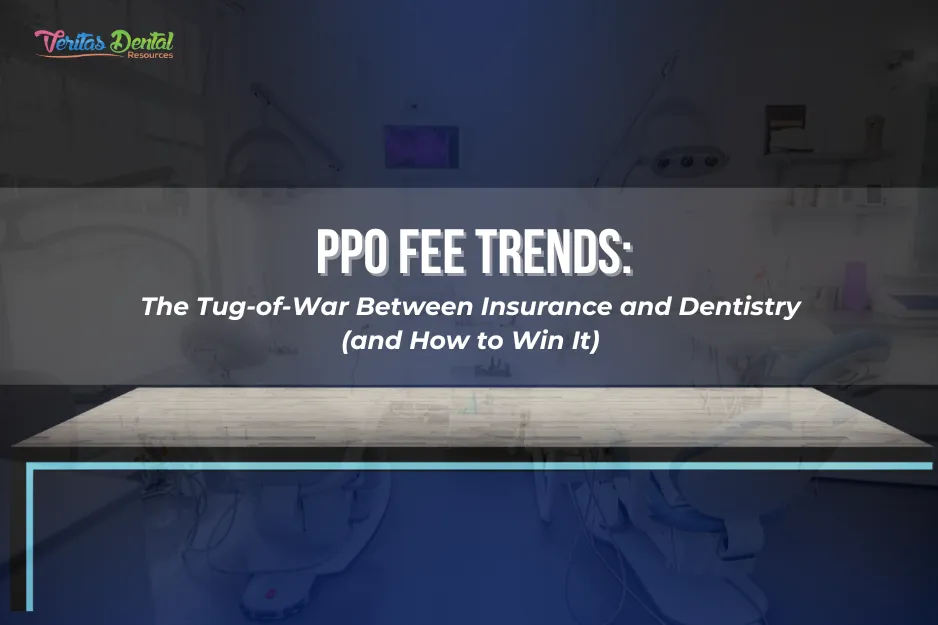
PPO Fee Trends: The Tug-of-War Between Insurance and Dentistry (and How to Win It)
By someone who’s been in the dental trenches long enough to know that "usual and customary fees" are anything but
Imagine charging the same for a crown in 2025 as you did in 2005, while paying triple for rent, double for lab costs, and offering your staff competitive salaries just to keep them from jumping to the orthodontist down the street. Welcome to the wild, frustrating world of PPO fee schedules.
Let’s pull back the curtain on how PPO fees are set, why they don’t keep up with inflation, and what dentists can do about it, besides scream into their impression trays.
How Are PPO Fees Determined?
You’d think fee schedules would be built on transparent, data-driven logic. You’d be wrong.
Insurance companies often claim their PPO fee schedules are based on “UCR”—Usual, Customary, and Reasonable fees. But here's the catch: they get to decide what’s usual, customary, or reasonable. And spoiler alert: it’s usually unreasonably low.
They collect data, sometimes decades old or based on cherry-picked zip codes, to justify their fee caps. Some payers haven't touched certain CDT codes in over a decade. Meanwhile, everything from gloves to gauze has tripled in price.
Why Haven’t PPO Fees Kept Up with Inflation?
In a word? Profit.
Dentistry is one of the last healthcare professions where reimbursement hasn’t followed inflation. A root canal that netted $800 in 2002 might only pay $750 today. During the same period, consumer prices jumped over 70 percent.
Why? Because insurance companies don’t have to increase fees unless you make them. Most fee schedules are “set and forget,” unless the dentist (or their savvy fee negotiator) pushes for an update. And unlike medical plans, there’s no federal mandate tying dental fees to inflation or cost-of-living indexes.
Are Insurance Companies Colluding?
Ah yes, the quiet part no one says out loud.
Insurance companies can share aggregated fee data under the guise of “market analysis,” especially through third-party organizations. While they technically can't collude to fix prices, they can study each other’s data in ways that look suspiciously like collusion without legally being called that.
The McCarran-Ferguson Act gives insurance companies partial antitrust exemptions, meaning they operate under lighter federal scrutiny compared to other industries. So while dentists are bound by antitrust laws, insurers have a legal playbook that lets them “collaborate” under certain conditions.
Why Can’t Dentists Band Together?
This one stings. If dentists organized to demand higher fees collectively, it’d be considered price fixing or antitrust violation.
Even though insurers can aggregate fee data, dentists can’t negotiate as a group unless they’re formally organized as a legal entity, like a DSO or a group practice. The Federal Trade Commission has cracked down hard on independent providers trying to negotiate collectively, even if they’re just discussing standard fees.
So your study club? Can’t negotiate. Your state association? Also can’t negotiate unless they jump through massive legal hoops.
Why Have Annual Maximums Barely Budged Since 1960?
Remember when gas was 25 cents and dental insurance covered a full mouth of crowns? Okay, maybe not that good, but close.
Dental insurance plans launched in the 1950s with an annual maximum of about $1,000. Fast forward 70 years, and what’s the average annual max today? Still $1,000 to $1,500.
Adjusted for inflation, that’s like giving patients $150 worth of benefits in 1950s dollars. Which is great if you want to time-travel back to when amalgam was king and OSHA wasn’t a thing.
Insurers have no incentive to increase maximums. Why? Because dental plans aren’t truly “insurance.” They’re prepaid benefit plans designed to cap costs, not cover them fully. The less they pay, the more they profit.
So What Can Dentists Do?
Here’s the good news. You’re not powerless.
While you can’t form a dentist union and storm the gates of Delta Dental, you can fight back smartly and legally. Here’s how:
Negotiate Your PPO Fees
Yes, you can negotiate. But here’s the kicker: you have to ask. Many dentists don’t even try. Some plans respond to a single well-written request. Others require persistence, data, and strategy.Use Real Market Data
Show insurers what your region’s UCR fees actually are. Compare cost-of-living trends. Provide evidence of inflationary pressures. Carriers aren’t always quick to cave, but data puts pressure on them.Hire the Pros
This is where Veritas Dental Resources enters the chat. With decades of experience and a track record of helping over 9,000 dentists raise PPO reimbursements, Veritas takes the guesswork out of negotiations. Whether you’re solo or part of a group, they know how to navigate each payer’s quirks and push for the increases you deserve.
Bonus: New clients often see increases of 10 to 40 percent, depending on the plan. That’s real money back in your pocket.
Final Thoughts
Dentists are being squeezed from every angle. Rising costs, stagnant reimbursements, and corporate players with billion-dollar war chests. But the fee suppression game only continues if you let it.
It’s time to stop accepting low fees as the cost of doing business. PPOs may dominate the insurance landscape, but you still have leverage. You just need the right strategy.
So sharpen those scalers, polish your narratives, and let Veritas Dental Resources help you fight for the fees you actually deserve.
Ready to renegotiate your PPO fees?
Visit www.veritasdentalresources.com and schedule your complimentary consultation. The only thing worse than low fees is staying stuck with them.
Benjamin Tuinei
Founder – Veritas Dental Resources, LLC
Phone: 888-808-4513
Services:
PPO Fee Negotiators · PPO Fee Negotiating · Insurance Fee Negotiating
Insurance Credentialing · Insurance Verifications
Websites:
www.VeritasDentalResources.com | www.VerusDental.com

